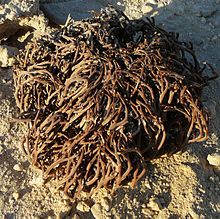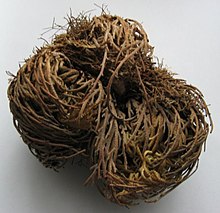| Revision as of 17:09, 4 January 2009 editUna Smith (talk | contribs)Autopatrolled, Pending changes reviewers23,024 edits see also← Previous edit | Revision as of 23:56, 4 January 2009 edit undoUna Smith (talk | contribs)Autopatrolled, Pending changes reviewers23,024 edits fix linkNext edit → | ||
| Line 1: | Line 1: | ||
| {{otheruses4|the ]|plants and other things called tumbleweeds|Tumbleweed (disambiguation)}} | {{otheruses4|the ]|plants and other things called tumbleweeds|Tumbleweed (disambiguation)}} | ||
| ] | ] | ||
| {{wiktionarypar|tumbleweed}} | {{wiktionarypar|tumbleweed}} | ||
Revision as of 23:56, 4 January 2009
This article is about the diaspore. For plants and other things called tumbleweeds, see Tumbleweed (disambiguation).
A tumbleweed is the above-ground part of a plant that, once mature and dry, breaks away from the root and tumbles (rolls) away in the wind. Usually, the tumbleweed is the entire plant apart from the roots, but in a few species it is a flower cluster. The tumbleweed habit is most common in desert and steppe plants and serves to disperse the propagules (seeds, spores).
Plants forming tumbleweeds



Although the tumbleweed habit is extremely rare in terms of the number of species that have it, several of these species are common agricultural weeds.
Although thought to be native to Eurasia, several annual species of Salsola (family Amaranthaceae) that form tumbleweeds have become so common in North America that they are a common symbol in Western movies, where they are used to indicate overgrazing and abandonment. Salsola pestifera became naturalized over large areas of North America after being imported from continental Asia often in shipments with agricultural seeds. Salsola kali is said to have arrived in the United States in shipment of flax seeds to South Dakota in the nineteenth century.
Salsola tragus is an annual plant that breaks off at the stem base, forming a tumbleweed that disperses its seeds as it rolls on top of the ground. It seems to have been imported into South Dakota from Russia in 1870 or 1874 in shipments of flaxseed. It has become a noxious weed that has spread throughout North America to inhabit suitable habitats which include areas with disturbed soils like roadsides, cultivated fields and eroded slopes, and in natural habitats that have sparse vegetation like coastal and riparian sands, semi-deserts and deserts. Salsola tragus is the correct name for the narrow-leaved, weedy representative of the S. kali aggregate found widely over North America. It is an extremely variable species with many races which vary in distinctness, some of these varieties in the past have been divided into subspecies or even separate species. Though it is a noxious weed, Salsola tragus is useful on arid rangelands as a forage for livestock.
Other members of the family Amaranthaceae that form tumbleweeds include Amaranthus albus, native to Central America but introduced and weedy in Europe, Asia, and Australia; Amaranthus graecizans naturalized to North America from its native Africa; Corispermum hyssopifolium; Cycloloma; and Kochia.
In the mustard family (Brassicaceae), Sisymbrium altissimum and Anastatica (a resurrection plant) form tumbleweeds. Very similar in habit to Anastatica, but very distantly related, is the lycopod species Selaginella lepidophylla.
In the legume family (Fabaceae), some members of the genus Psoralea form tumbleweeds.
Anatomy
In some tumbleweeds this habit is achieved by means of abscission of the plant stem; abscission has been shown in Psoralea and Kochia. In some species of the parsley family (Apiaceae) the tumbleweed is formed by the flower cluster rather than the whole plant.
See also
External links
References
- ^ William Francis Ganong (1921). MacMillan Co. p. 604 http://books.google.com/books?id=RkgaAAAAYAAJ.
{{cite book}}: Missing or empty|title=(help); Text "A Textbook of Botany for Colleges" ignored (help) page 359 - Epple (1997). Plants of Arizona. Falcon. p. 352. ISBN 978-1560445630.
{{cite book}}: Unknown parameter|name=ignored (help) - http://www.efloras.org/florataxon.aspx?flora_id=1&taxon_id=242100193
- Abrams, LeRoy (1944). Illustrated Flora of the Pacific States Volume 2. Stanford University Press. p. 644. ISBN 978-0804700047.
- Template:Cite article
- Template:Cite article